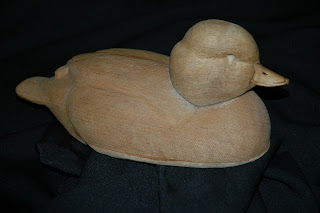This is a site to record my decoy carving. I also work in watercolor and have done some bronze casting.
Wednesday, July 14, 2010
Buffel Head Duck Decoy at Pacific Flyway Decoy Show
This show was held in Sacramento on July 9th -11th at the Double Tree Hotel. I am showing my ducks in the IWCA style competition. This is a hunting style decoy that is required to self right when turned over.
Thursday, July 1, 2010
Sunday, June 13, 2010
Greeenwing Teal in the undercoat paint or gesso
Keel & Keel Weights
Monday, March 22, 2010
Fitting The Head
I used palm straight chisel and gouge to shape the body to accept the head. The same tools are used on the head to get it to fit down in the neck cavity. I want to get a realistic look. This bird is relaxed and settled and just paddling around. It is a good look for a decoy and would covey a safe place to land for birds coming in.
Wednesday, March 17, 2010
Buffelhead Duck Decoy a Self righting Working Decoy

These photos are of a duck on my work bench that I am fine tuning. I have cut the bottom so that I can hollow it out. The decoys are hollow for several reasons. One is to relieve the pressure and hopefully avoid cracks in the finish duck later. Another reason is to permit self righting when the decoy is blown over in the marsh.
I use a Foredom flexible-shaft tool with a carbide burrs to remove the wood from the interior. Be sure to wear eye protection, a mask and use a dust collector for this process. I then finish the interior by hand to smooth the interior. Some carvers don't do the last step but I feel that I get a better balance and it is worth the effort.
Snowy Egret
This is a decoy I did about 20 years ago. It actually decoyed a wildlife fish and game officer while I was out in the field with the photographer taking this shot. From a distance he thought we were bothering a wild bird and came to investigate it. I made my own pattern from watching the wild birds in the marsh in Suisun California.

Welcome to my first blog. I thought that I would share some of my carving tips and tricks with fellow carvers. I hope to get comments and suggestions from begining to advance carvers. I have taught carving on and off over the years to sudents in their teens up to seniors. I find it to be a sometime profitable experiance but always rewarding past time.
Subscribe to:
Posts (Atom)












